After the Great Gefilte Fish Fiesta, we ended up with a lot of strong fish stock and two large gefilte fish balls. So it was time to cook with leftovers. This was a while back, just after the original gefilte fish thing, but I lost track of the photos, so this took a while to post.
The thing is, the Japanese don’t usually make stock in our sense of the word. Dashi, the basis of just about all Japanese cooked food, is made by extracting flavor from kombu (kelp) and often some sort of dried and salted fish product, most commonly katsuo bushi (salted, smoked, dried bonito in shavings). Taking bones and meat scraps and simmering them with some vegetables for a while is a similar process, but it doesn’t come up almost at all in Japanese cooking. That’s one of the ways you know ramen noodles are Chinese, not Japanese, in origin: the soup is stock, not dashi. So here’s me in Kyoto with a couple of quarts of great fish stock. What to do?
My first thought was one of those great Mediterranean fish soups: bouillabaisse, bourride, and so on. But I am informed that there is a special circle in Hell for people who eat these soups without crusty bread, so that wasn’t going to work. Passover has its down side.
Then I thought of Korean soup-stews. I surfed around the Internet to find some recipes, and eventually cobbled together something that seemed workable.
Passover Chigae
Here’s the mise en place for the stew, in no particular order. Chopped onions, slivered negi, two eggs, minced garlic, some shaved beef, cut-up gefilte fish, pack of fresh soft tofu, jar of kimchi, big bowl of stock (not all of which got used). Front-left, a little packet of spicy sesame miso, which I figured would be a decent substitute for gochujang, which is Korean spicy fermented soy paste. In the back, sesame oil, hot chile oil, and a bottle of kimchi juice, something you can get very easily here and which everyone apparently puts in chigae.
In case you’re wondering, Sam and Maia got udon soup noodles, which are about as far from spicy as it’s possible to be.
First up, start cooking the beef and the garlic in some sesame oil.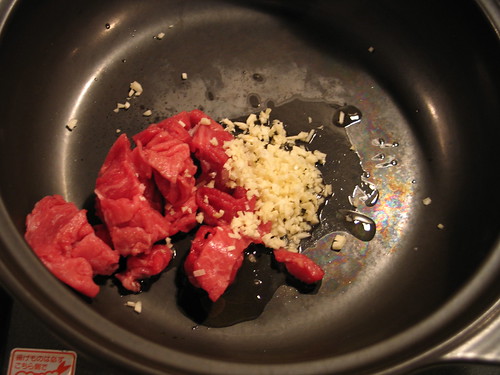
Add kimchi and a bit of kimchi juice.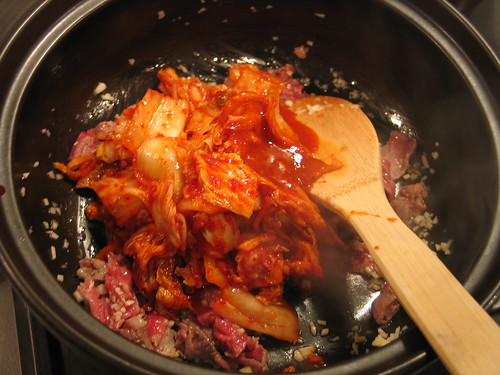
Add onion.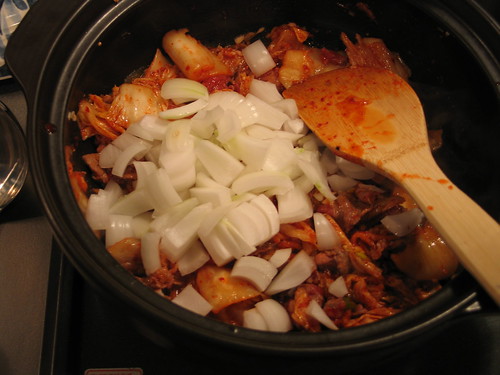
When the stuff all seems basically cooked, add enough stock to make a thickish soup-stew. If you add a whole bunch, it gets watery, because the tofu will throw water of its own.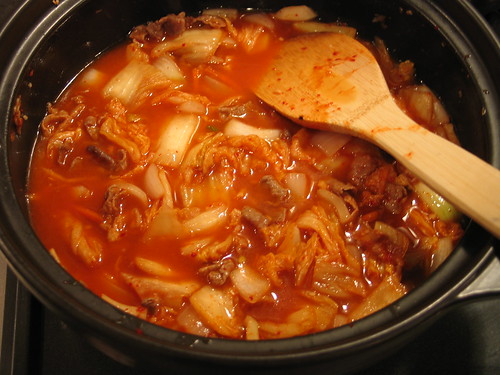
Bring to a strong simmer, taste, and add a splash or so of hot chile oil and another of sesame oil. Then add the gefilte fish balls and return to a strong simmer. (In the normal Korean dish you’d add fresh seafood, you see.)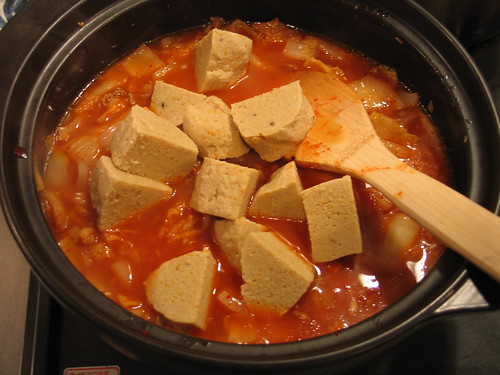
Add the tofu in large cubes. You can also add the whole pad and kind of break it up coarsely, but the wife likes cubes. Bring to a boil, then reduce to a medium simmer.
Now I added a couple Tb of the spicy sesame miso. In some Korean recipes, they add gochujang somewhere along the line, and in others you see shrimp jut, which I’m not quite sure what it is. There’s also something called guk ganjang, which looks a lot like gochujang in the one photo I’ve seen, but I have no idea. Anyway, I added the miso at this point because you generally don’t want miso to be boiled, only simmered.
Once the miso was mixed in, I cracked two eggs on top and sprinkled with the negi shreds.
Now cover, bring to the tabletop induction burner, and bring the temperature to a gentle simmer. Wait a minute or two for the eggs to just barely set, and...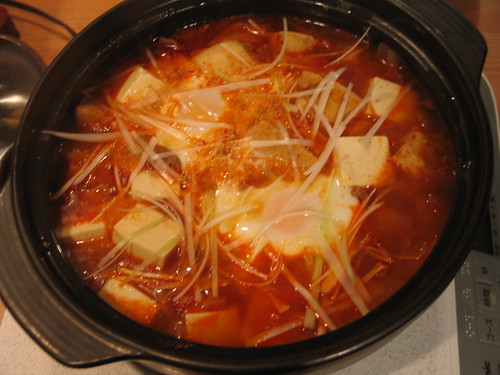
Ta da!
The Envelope Please...
Pretty delicious, a definite success. We got enough for four generous servings, easy, and the two of us polished off about two-thirds, so we were groaning a bit, fat but happy. It was spicy, but not blazing, with lots of complexity and depth. The gefilte fish chunks had a slightly odd texture for this stew, but mostly because we knew what they were in advance; I think if I had made gefilte fish with a little Korean twist along the way, such as a hint of garlic and sesame oil, it would have clicked perfectly. To top it off, the dish was disturbingly healthy, yet tasted like something self-indulgent.
A winner! Next time you have leftover gefilte fish, you know what to do.




No comments:
Post a Comment